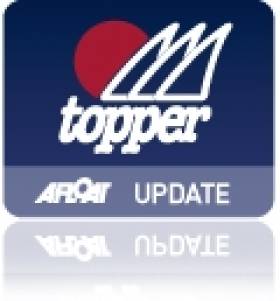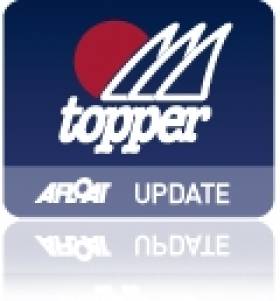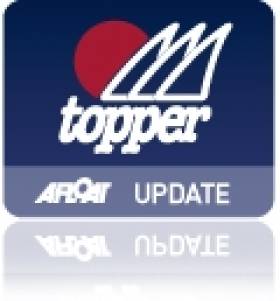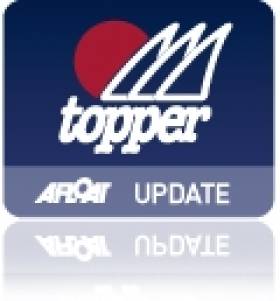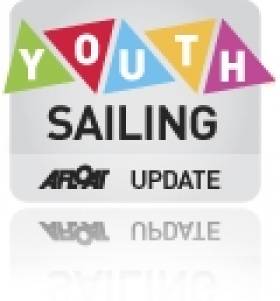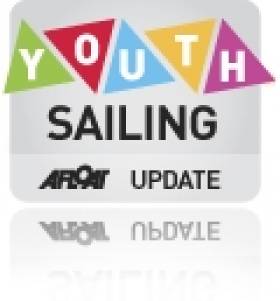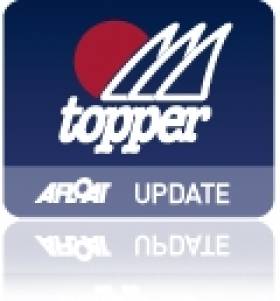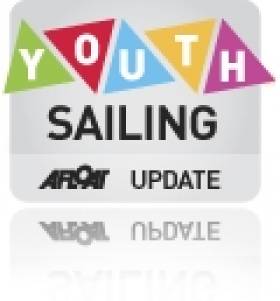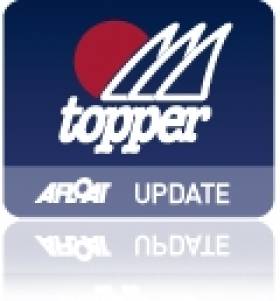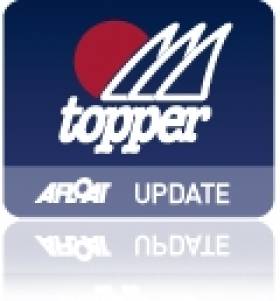Displaying items by tag: Topper
Strangford's Gilmore Finishes Sixth in British Topper Nationals
That concludes the British Nationals, now the class look forward to the Topper Worlds Championships held by the National YC, Dun Laoghaire from the 14-19 August.
Final Irish Results:
GOLD
Laura Gilmore 6th
Timothy Brow 17th
Jack Brien 19th
Dougie Power 25th
Craig Campbell 26th
Erica Ruigrok 60th
Andrew Penney 72nd
Conor O'Farrell 73th
Sorcha Donnelly 79th
Tom Purdon 86th
SILVER
Aisling Keller 5th
Kevin Harrington 40th
Suzanne Flannigan 46th
See here for full results.
Gilmore Leads British Topper Nationals
Laura Gilmore, from Strangford Lough, who has already won the Ulster Championships now leads the top British event going into the last race today.
On Tuesday which was Day 3 of the Championship, the heavens opened up in Scotland. A mammoth amount of rain fell, which coupled with no wind i.e. 1 knot gusting, meant that no races were completed.
With only two races completed the qualification series was extended to Day 4. It was a more promising day with much less cloud cover giving signs a light sea breeze could later develop.
Eventually after much wind speed up and down and moving the course inland to escape the massive tide (sometimes up to 2 knots or more), the wind stabilised to 5-6 knots at about 4pm.
The PRO was under pressure to get races in and as time got later and the fleet behaved more and more badly the races were confined to 1 lap, just 20 minutes per race. Not ideal for a National Championship but such was the nature of this week so far.
The breeze did pick up to 12 even 13 knots at times with the tide playing a huge roll for numerous black flags through the day. Up to 80 sailors were penalised over the two races from the day as the tide pushed the fleet over the line time and time again.
The Irish results were much better and after the discard all Irish sailors have made Gold and Silver Fleets with just two in the minor. Laura Gilmore with two more bullets took the overall lead in the championship. The 3rd race of the day was cancelled for safety reasons due to a deep fog approaching and the fleet returned ashore at 7pm.
Results and Final Fleets:
GOLD
Laura Gilmore 1st
Craig Campbell 16th
Dougie Power 19th
Jack Brien 36th
Timothy Brow 51st
Andrew Penney 56th
Erica Ruigrok 68th
Tom Purdon 69th
Sorcha Donnelly 78th
Conor O'Farrell 89th
Aisling Keller 91st
SILVER
Kevin Harrington 100th
Suzanne Flannigan 127th
Gilmore Wins Topper Ulsters Sailing Championships
Tim Brow from Ballyhome Yacht Club came second overall while Craig Campbell from the Cultra-based Royal North of Ireland Yacht Club finished in third place.
Laura Gilmore won three of the six races, also recording a second and third place finish.
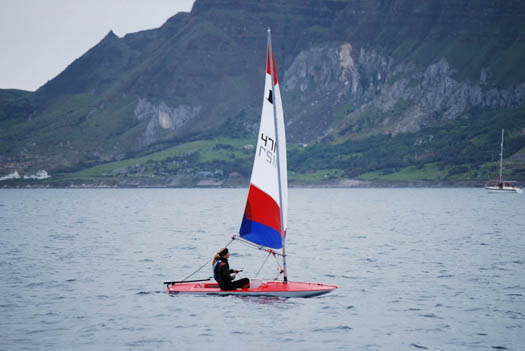
Event winner Laura Gilmore from Strangford Lough Yacht Club at the Topper Ulsters sailing championships, which were held in Cushendall last weekend. Photo: Tim Hopkins. Scroll down for more photos by Tim.
Ellen McCarlie from Whitehead's County Antrim Yacht Club came first in the reduced rig 4.2 division.
Seven members of Cushendall Sailing and Boating Club took part in the races, with Owen McKinley finishing at the top of the local fleet.
Competitors from 14 clubs across the country entered the event.
Club Commodore John Lowry said: "It was great to have so many sailors competing in Red Bay this weekend. We had a mix of weather conditions and I am glad that so many competitors and their families travelled to the Glens for our event.
"As Cushendall Sailing and Boating Club celebrates its 50th anniversary, we have a full calendar of sailing and social events throughout the year. Later in 2011 Cushendall will host the national RS200 and RS400 championships and the regional East Coast championships for the Flying 15 class. We are really looking forward to a summer packed full of great sailing events. And we look forward to welcoming hundreds more visitors to Cushendall and to our club."
Cushendall Sailing and Boating Club was established in 1960 and is today a busy sailing hub on the North Antrim Coast. It provides competitive sailing facilities, races for both cruising yachts and sailing dinghies and a popular summer sailing school. It also has active rowing, sea angling and motorboating sections.
Since 1998 sailors from the club have competed at provincial and national Topper and Laser class competitions as well as other open events. Cushendall sailors have won the Northern Ireland Youth Championships, the Irish Topper championship and Irish team titles.
CSBC has hosted Optimist and Topper regional championships, the Irish Topper Championships and the Skydome Topper World Championships in 2000. Other classes of boats sailing at the club include: Flying Fifteen, Laser, Pico, Buzz, Laser 2000 and RS400.
Cullaun Sailing Club Launch New Omegas
The club was particularly happy to form links with Sean Hehir of Kilkishen National School and to extend sailing to the children of the area. The club is having an introductory sailing weekend for the senior classes of the school on 11/12th of June and many of the children will be attending the junior sailing course from 4th to 15th July. The adult introductory weekend is scheduled for the 28th/29th of May and already has much interest from the local area and further afield. The advantage of the new fleet means that people can start to sail with only a track suit and runners, allowing greater access to sailing from within the local community.
Father Hugh O'Dowd and Rev. Bob Hanna lead the members and public in a lovely reflection and reading to bless the club and boats for the year. As the weather was too wild for sailing, it was a chance to eat cake, to welcome new members and to chat to people interested in sailing. Club racing will continue on Thursday nights for the summer and novice sailing will commence on Sunday mornings in June. The clubs web site www.cullaunsailingclub.com has a list of forth coming events and may be used to contact the committee.
Brow is Topper National Champion
| Rank | CLASS | SAIL NO | HELM | CLUB |
|---|---|---|---|---|
| 1st | Topper | 47083 | Tim Brow | Ballyholme YC |
| 2nd | Topper | 46568 | Laura Gilmore | Strangford Lough YC |
| 3rd | Topper | 47097 | Andrew Penney | East Antrim BC |
| 4th | Topper | 46422 | Lucy Burrows | Donaghadee SC |
| 5th | Topper | 46190 | Erica Ruigrok | Rush SC/Skerries SC |
| 6th | Topper | 45111 | Craig Campbell | Royal North of Ireland YC |
| 7th | Topper | 46717 | Conor O'Farrell | Carlingford Lough YC |
| 8th | Topper | 45526 | Katie Kane | East Antrim BC |
| 9th | Topper | 46737 | Gary Fekkes | East Antrim BC |
| 10th | Topper | 46897 | Amy Lambert | National YC/Lough Derg YC |
| 11th | Topper | 46714 | Suzanne Flannigan | Ballyholme YC |
| 12th | Topper | 46934 | Dougie Power | Waterford Harbour SC |
| 13th | Topper | 46957 | Liam Glynn | Ballyholme YC |
| 14th | Topper | 46105 | Sorcha Donnelly | Skerries YC |
| 15th | Topper | 25924 | Sam Wilkinson | Donaghadee SC |
| 16th | Topper | 47068 | Aisling Keller | Lough Derg YC |
| 17th | Topper | 46975 | Conor Sherriff | Courtown SC/National YC |
| 18th | Topper | 44948 | Kevin Harrington | Courtown SC |
| 19th | Topper | 46918 | Grainne Young | National YC |
| 20th | Topper | 46444 | Sarah Cooney | National YC/Lough Derg YC |
| 21st | Topper | 46569 | Nicola Eames | Strangford Lough SC |
| 22nd | Topper | 45549 | Anna Potterton | Waterford Harbour SC/ Howth YC |
| 23rd | Topper | 42125 | Rory Butler | Donaghadee SC |
| 24th | Topper | 45418 | Alison Dolan | Blessington SC |
| 25th | Topper | 46189 | Tom Purdon | Strangford Lough YC |
| 26th | Topper | 44541 | Niamh Doran | Courtown SC/National YC |
| 27th | Topper | 46313 | Peter Queally | Waterford Harbour SC |
| 28th | Topper | 46144 | Peter Gilmore | Strangford Lough YC |
| 29th | Topper | 44703 | Milo Dunne | National YC |
| 30th | Topper | 46298 | Luke Gleeson | National YC |
| 31st | Topper | 46429 | Iseult Kneafsey | National YC |
300 Top Junior Sailors Bound for Dublin Bay
Over 300 sailors will compete in Dublin Bay in seven different classes (Laser Radial, Laser 4.7, 420, Feva, Topper, SL16 and Optimist). For youth sailors, this event is the most important in the annual calendar as it is the decider for the top Irish sailors to compete internationally during 2011 and is the pathway for future Olympic sailors. Podcast with Olympic Team Manager James O'Callaghan here.
The 420 fleet is already in situ as the Leinster Championships were held over Easter and the girls team Emma Geary and Niamh Connolly won the event in style. This team is the only 420 crew to qualify internationally for a place on the Irish team to compete in the ISAF Youth Worlds in Zadar, Croatia and will be looking to win next weekend to secure this honour.
Dublin Bay will host the 2012 ISAF Youth World Championships and this year's ISA Mitsubishi Youth National event is an important test event with representatives from the international sailing authority visiting Dun Laoghaire to view plans and test logistics.
In addition to the 420 fleet the Laser radial fleet will also be competing to qualify to represent Ireland in Croatia. Philip Doran aged 17 from Courtown in Wexford is the current former under 17 World Champion in the Laser Radial fleet although the National title has eluded him so far. In the girls fleet it will be a toss up between Saskia Tidey (RIYC) and Sophie Murphy (Quoile YC) as both already have a national title each under their belts.
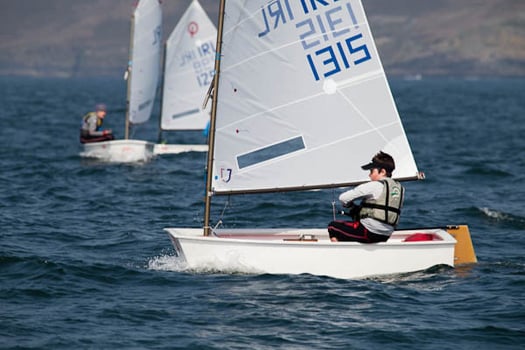
A fleet of top Optimists are expected. Photo: Bob Bateman
The younger Optimist fleet is also celebrating this week after two top 5 positions at the Easter Regatta in Braassemermeer, the Netherlands. In fact an Irish team has competed at this event for 23 years and this is the first time that Ireland has won the country prize. Sean Donnelly from Dun Laoghaire who finished fourth in Braassemermeer is also leading the Optimist fleet in the trials and will be anxious to hold on to first position during the ISA Mitsubishi Youth Nationals.
In other fleets, the laser 4.7 fleet is enjoying record numbers with many ex-Optimist and Topper sailors choosing this boat. Finn Lynch from Blessington and Seafra Guilfoyle from Cork will be firm favourites to win the class.
Overall Dublin Bay will be a spectacle of sail over the May Bank holiday weekend with light winds forecast.
Mitsubishi Motors have been a proud supporter of junior sailing in Ireland for the last 7 years. In recent years Ireland has had successes at youth level with winner of the girls under 21 Laser World Championships and a top 10 at the 2010 ISAF Youth Worlds and wins at the British National Optimist Championships.
Dun Laoghaire Set for Topper World Champs
The club is expecting a turnout of up to 300 sailors that will make it the biggest dinghy sailing event in the country this year. "We will have a large contingent from the UK and many sailors from far away – we have had interest from Korea, Japan and Hong Kong, for example". Says Margaret Margaret Kneafsey, Chairperson of the Organising Committee.
Carlow sailor Finn Lynch, 16, who is the reigning British and Irish champion finished third in the 2010 World Championships in Lake Como, Italy.
The event has its own website with details on accommodation and logistics and entries.
Northern Ireland Yacht Club Awarded Volvo RYA Champion Club Status
Carlingford Lough Yacht Club in Northern Ireland has been presented with the prestigious Volvo RYA Champion Club award. Carlingford Lough has been recognised for its very active racing programme focusing on the Laser 4.7, Radial and Topper classes. The club encourages and supports talented young sailors to develop and progress throughout the RYA Youth and Olympic programmes.
The presentation was held at the Yacht club's annual dinner dance and presentation at local Whistledown Hotel, Warrenpoint. Commodore, Michael McCann understands the importance of developing the club's youth sailors "We are all very delighted and proud to have been awarded the coveted Volvo Champion Club status. This achievement is a reflection of the great work, dedication and energy which has been put into youth and junior sailing in recent years.
While a number of senior club members have been involved along the way I must single out our past sailing secretary Dr Henry McLaughlin who worked to fulfil the arduous requirements necessary to gain this recognition. The Club would also like to thank Volvo and the RYANI for this award and we will continue to work with them to promote Championship level sailing in the region."
The club's junior training programme is run by 8 regular volunteers who are committed and dedicated to helping with the racing, training and the club's busy social programme. For the past three years the club has had five juniors in the RYA Volvo national squad and at the 2010 RYA Volvo Zone Home County Championships in Northern Ireland two of the members excelled both finishing in second place.
Carlingford Lough Yacht club is one of only 12 clubs in Northern Ireland and 171 nationwide to be awarded the esteemed Volvo RYA Champion Club status. Richard Honeyford, RYA High Performance Manager for Northern Ireland presented the club with the award "I am delighted to be presenting this award in recognition of the great work that Carlingford Lough Yacht Club has done to help young sailors to develop their racing skills. Following the success of British sailors at the Beijing Olympics, and with the 2012 Olympics fast approaching, we may well be training future Olympians here in Carlingford Lough"
The Volvo RYA Champion Club Programme aims to encourage young sailors and windsurfers at grassroots level to stay in the sport and learn to compete, while encouraging clubs to introduce youngsters to the sport and help develop their skills. The key challenge for the programme is to encourage more young people to start participating in sailing and then progress with their racing careers.
Now Carlingford Lough Yacht club has been awarded the Volvo RYA Champion Club status, the sailors will see increased levels of development advice and professional coaching including support from the RYA. Carlingford Lough will also have access to the recent commitment from Sport England of £1.1m to the RYA's flagship youth sailing initiatives, to further enhance club coach and volunteer development across England over the next three years.
National Yacht Club to Stage 2011 Topper Worlds
The 2011 Topper World Championships will be hosted by the National Yacht Club in Dun Laoghaire.
The club beating off stiff competition from around Europe to secure this major sailing event. It follows the successful 2010 Topper Worlds held at Lake Garda last August. The news was confirmed by Bill Brassington, President, International Topper Class Association.
Over 250 of the world's top youth sailors are expected to partake in the Irish event which will run from August 15th - 19th 2011 and promises some of the closest and most exciting youth sailing ever seen on Dublin Bay.
The Topper is one of the world's most popular youth boats with over 50,000 boats around the globe. It has grown greatly in popularity in recent years because it suits the learner sailor as well as those with ambitions of Olympic medals. Because it is exceptionally light and easy to transports the National Yacht Club are expecting 150 competitors from other countries to partake.
National Yacht Club Commodore Peter Ryan commented on the announcement: "We are delighted to be hosting the Topper World Championships next August. It will follow on from the Figaro Race stop over and reflects that fact that Dublin Bay can cater for top class events for both ends of the spectrum. The Topper is an extremely popular boat with young sailors and a great gateway to sailing so we will be putting all the club resources into making the event an outstanding success."
The Topper was designed by Ian Proctor whose other boats include the ever popular Wayfarer. It was originally constructed in GRP but this was changed quite early on to an injection moulding construction. After well over 20 years of continuous production it is the outstanding build quality, durability and innovative design features that have made the Topper a very popular boat. The Topper hull is injection moulded with incredible precision, reaching a level of uniformity quite outside the scope of any other production system, either hand built or mass produced in GRP or roto-moulded plastic. The material is polypropylene which has proved to combine strength and flexibility with lightness and virtually everlasting life.
Lynch Adds Leinster Title
Blessington's Finn Lynch added the Topper Leinster title to his 2010 roll of honour when he emerged as winner of the 50-boat event at the National Yacht Club in Dun Laoghaire today. The Carlow based teenager was the winner of the British Topper Championships sailed at Abersoch in August.
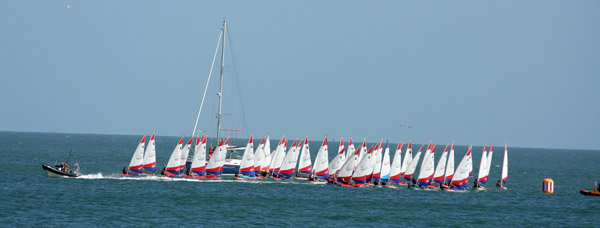
The start of the second race today in Scotsman's Bay


























